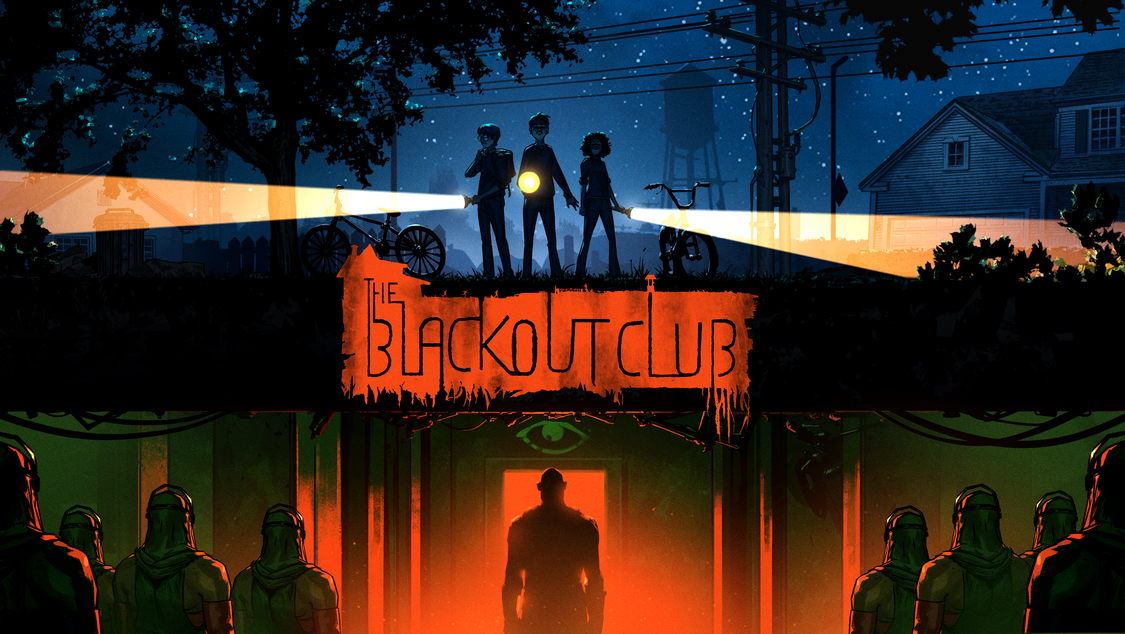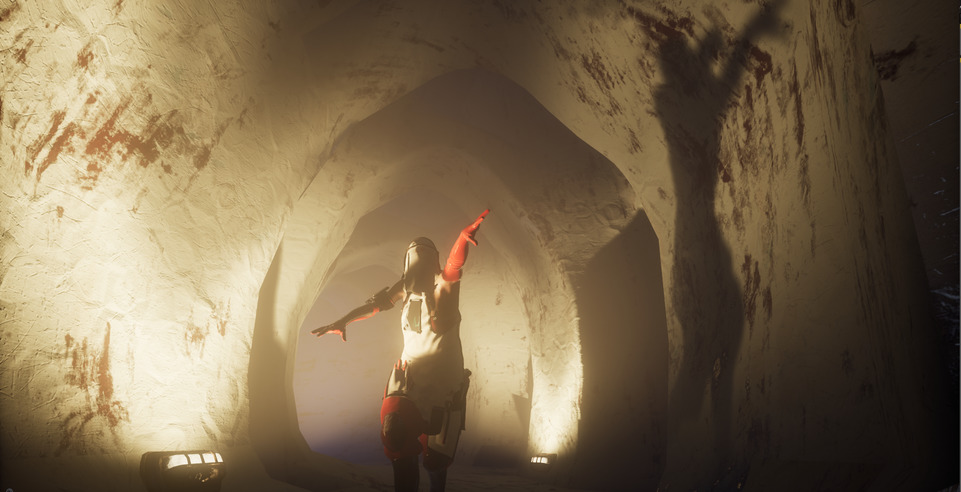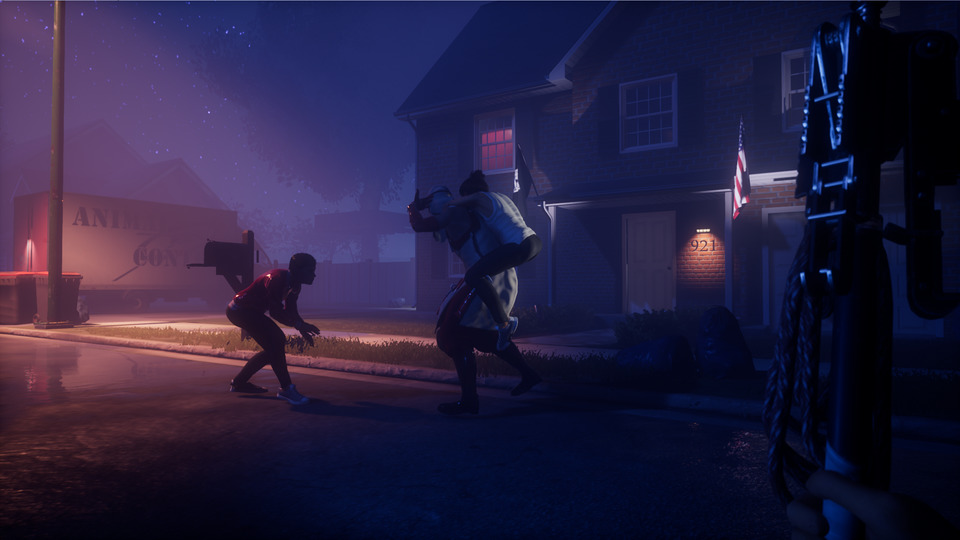To the uninitiated, the words “immersive sim” may not be entirely helpful in describing a game. The genre made famous by the likes of BioShock, Thief, and Deus Ex has been a favorite among those who want to approach every area with the curiosity of a mad scientist, toying with their world and observing how it responds.
But what if that world toyed with you, too? How would you respond?
That’s the thrill of Question’s The Blackout Club, a four-player co-op immersive horror sim that bends the rules of the genre in more ways than one. Some of those ways are so mysterious that our recent chat with Lead Designer Jordan Thomas left us with a cryptic teasing that players will unravel with the game’s 1.0 launch on July 30.
We caught up with Thomas to find out more about the game’s multiplayer environment and the cultish lore behind the game, all while trying to get to the bottom of its mysterious Enhanced Horror feature.
GameSkinny: When I first heard about The Blackout Club, I likened it to Left 4 Dead meets Stranger Things, but for reasons we’ll get to momentarily, I now feel like that doesn’t fully capture the game’s essence. For those unfamiliar, what’s the basic premise of The Blackout Club?
Jordan Thomas: Sure! The Blackout Club is first-person, modern co-op horror with a twist. You play teenagers investigating a potentially supernatural threat beneath the streets of your hometown. Everyone is sleepwalking at night, experiencing blackouts, and you want to know why. The enemies are bigger than you, and they could be your parents, so the focus is on non-lethal sneaky or mobility-focused tactics.
You can also play a traitor kid called The Stalker, who is trying to catch the Blackout Club kids on camera. It’s harder, because you’re all alone, but can be thrilling. Some of the kids report hearing voices that claim to be ancient, and know things they should not — and part of the game involves interacting with those voices.
GS: Playing The Blackout Club at PAX West last year, I was surprised to learn the National Radio Quiet Zone is a real thing here in the U.S. Was the intent to always place your game in this area or did that come later as you fleshed out what The Blackout Club would be?
Thomas: I’ve told other, private stories in this universe, and there was — well, our term is a “strong edge metaphor.” A reason why a single phone call or bus across state lines wouldn’t solve the protagonists’ problems. It’s so frustrating when you’re enjoying some genre piece and for completely baffling reasons they won’t do the rational thing to take themselves out of harm’s way.
Redacre, our fictional town, is on a private network controlled by the antagonists, and they have people watching the borders. Though the NRQZ is our unique take on that for this game, it was a decision we made fairly early.
Plus, nobody believes a group of kids who say, “Hi, you don’t know me, but my town’s possessed.”
GS: What were some of the chief inspirations for The Blackout Club?
Thomas: Well, there’s all the alter-ego oriented horror I love, starting with Jekyll & Hyde. The vast, unknowable maze beneath the earth, somewhat inspired by House of Leaves, though we leave more room for reasonable doubt about whether mortal forces could achieve it all, or if there truly is something supernatural happening.
As far as TV and film — Twin Peaks, It Follows, Stranger Things, The X-Files, Supernatural… some folks have drawn parallels with American Gods. Our goal was to draw on a great number of sources, but synthesize it into something that feels like its own animal. It’s very gratifying to hear that now, you might feel we’ve done that.
In games, I’d have to say Eternal Darkness. Horror that seems to reach back out through the controller to grab you back.
GS: How scary is it intended to be?
Thomas: The single-player intro has definitely brought a few folks to their limit, because they have maximal vulnerability and minimal information at that point. Once you’ve got your friends along and they’re carrying a metaphorical elephant gun packed with memes, it can lean into the comedy side of horror.
Accounting for that tonal variance was pretty key for us early on, and another reason we chose to go with teenage protagonists — humor is a defense mechanism, after all. That said, it is extremely satisfying to hear a certain kind of player go from cocky and vocally dunking on the challenge level to impress their friends to shrieking in front of those self-same friends a moment later. And that’s just within typical gameplay.
There are times when The Blackout Club makes things more personal for players who have enabled Enhanced Horror — and some of the things they report, we definitely did not put in the game. That may sound like hyperbole, and to an extent, sure, I’m being mysterious. But it’s true: the feature’s black-box nature causes players to project a lot of meaning onto what happens, and we are listening to what they believe, and altering the world, by degree, in response.
GS: The central villain is The Shape, a monster pulled right out of horror cinema in some ways. Can you talk about the ways in which The Shape interacts with players?
Thomas: The Shape is a nickname the kids chose, and horror folks will probably guess why. The sleepwalkers call it The Angel, and it does serve a sort of moral enforcer role in Redacre, monitoring the children for the worst “sinners” (as it perceives that term).
When one of them has committed too many sins while running a mission, a menacing song plays on the city-sized instrument under the town’s streets, and it is deployed to hunt that kid down. It cannot be seen unless the player closes their in-game eyes, and then it appears as a kind of burning shadow that … changes as things intensify.
When it gets ahold of them, at first, it turns them into a sleepwalker that acts as a roving alarm system against fellow players. If their friends rescue them and they’re caught a couple more times, however, The Angel’s mercy runs out and it ends their lives.
GS: Who and what else will players contend with in Redacre?
Thomas: Sleepwalkers come in a couple of varieties. Mothers and fathers within the town, dressed in pyjamas and special CHORUS branded sleep masks. CHORUS is the housing association which arranged the internet- & cellular-free community of Redacre. The elite sleepwalkers wear these very striking white and red clothes. These uniforms help them labor on the Great Instrument under the streets, monitor their hearts, and protect them in that semi-hazardous underground environment.
In the morning, they remember nothing — they wake up with aches and pains, so families often have one or more people who are subconsciously spying for the enemy.
Lucids have bare faces, but the populace of Redacre has been brainwashed to see their faces improperly, a sort of concentrated face blindness, so they appear to be a writhing swirl of features. Unlike the sleepwalkers, they are fully aware of the conspiracy and are always trying to play Mr. Friendly with the kids, talking them out of hiding. The savvy Blackout Club kids are rarely fooled, however.
Finally, there are The Voices. Most of the kids report hearing one or more. Some of them claim to be demons, or even deities. They offer the kids knowledge, and better control over their potential talent — but at a price.
GS: Those who have been playing in Early Access share their stories of the Enhanced Horror feature. This is something which, as far as I can tell, no one has done before in games. Understanding you want some of the fun to remain hidden until players see it for themselves, can you detail how Enhanced Horror works? What is the game like if players elect to turn off Enhanced Horror?
Thomas: Yes, tricky to discuss without ruining it for the very people who most benefit from surprise. But at a coarse level, it is meant to function like a Ouija board, meaning that you can opt in to let it listen to you as you play.
In a way, occult amusements like that are a bigger inspiration than any of the media we talked about. Players in co-op are already chattering all the time via the in-game voice or Discord, etc. In The Blackout Club, what they say actually matters. To name a particular god or demonlike entity with its proper name, for example, might provoke a surprising result. Out of a match, players can use a Ritual Item to ask questions of the voices in their minds, and everything they say … actually matters.
Finishing a mission gives them a Dream, which lets them eavesdrop on what other players have asked for or stated, via these — and listen to the replies they received. If you’re lucky, your question might be the one that becomes a public Dream.
Players’ knowledge of the world lore is being driven by this system, in part, and they are quick to rush to Discord to speculate on what it means. Already, these interactions have shaped the story, gently, and behind a veil of mystery. They seem to get something out of it they can’t find elsewhere, which makes us wildly happy.
GS: Some of you on the team have a history with immersive sims like BioShock and Thief. How has that work history informed the design of The Blackout Club, and what’s it been like trying to map some of those features onto a multiplayer game?
Thomas: As with the story elements, it has been a process of choosing what serves the immediacy of a session-based multiplayer game, and letting the rest either fall away or be hidden within deep systems context where the power-users will find it eventually. In a Shock-like game, you frequently have one hand that is sort of a … murder boquet, guns, direct damage in so many colors. And the other that is sort of about putting the enemy in interesting states.
In The Blackout Club, you’re supposed to feel like a disempowered teenager from some of the media we discussed above, so those abilities are distributed across you and several other players, and the combinations require you to coordinate with them, or at least to get the drop on your enemies first.
GS: What is the game’s map like? Is the town fully accessible right away or must players work to progress through new areas?
Thomas: It is gated by player level, and is focused around the main hillside climb up to the place where CHORUS has centered their activity in town. There are forested areas, suburban homes, a daycare facility, and, of course, the underground maze.
The maze is a giant musical instrument as we’ve talked about, and it plays a central role in the fiction. That function hugely alters the appearance of the maze — I’m very proud of the work Stephen and CJ have done on the environment art side, it feels like no other game world I’ve ever seen.
GS: With the game involving a live element, how do you see it evolving over time?
Thomas: Without spoiling too much, there are community-wide story goals, and players can make progress towards them by running typical missions. The means by which they do so, though, aren’t readily exposed or easy to “game” — they involve interacting and discussing with other players, sending Rituals to the Voices, and hoping for a useful reply.
Periodically, we want to build larger updates and release them, reflecting the results of that great search for truth, but, of course, the amount of that we’re able to do will be driven by how well the game does.
“The Blackout Club makes things more personal for players who have enabled Enhanced Horror — and some of the things they report, we definitely did not put in the game.”
GS: Similarly, considering how the game changes with Enhanced Horror, does the team at Question have settled lore to build on or are you adjusting to player interactions as time goes on?
Thomas: The Blackout Club is meant to feel something like a less well-worn Call of Cthulhu or Hunter: The Vigil style game, where the protagonists are ultra vulnerable and only brush against the truth by aggregated effort. So there is a great deal of hidden truth that has existed for a long time, but already, even in Early Access, some tectonic shifts have occurred based on player interest.
So it will be a hybrid of the world as it is, and the world as they want to see it. Fitting, I hope, for a story that involves an element of growing up and grappling with reality. I’ll let you and the player community hash out how well we’re pulling that off!
GS: What does player progression look like? How does one beat The Blackout Club? Is there an ending to see or is it meant to be played more as repeat-friendly levels like Left 4 Dead?
Thomas: It is definitely meant to be endlessly replayed; the actual mission content is procedural/dynamically generated, the placement of enemies, lights, security, and so on will shift around. But it does begin with the story of a girl who got too close to the truth, and the players are just like the kids in the Blackout Club, they expect some kind of resolution to that arc.
Of course, if they send enough ritual offerings asking for something else, who are we to deny the power of belief?
The Blackout Club exits Steam Early Access and comes to Xbox One and PS4 all on July 30. You can read our early impression of the game here.









Published: Jul 15, 2019 07:01 pm